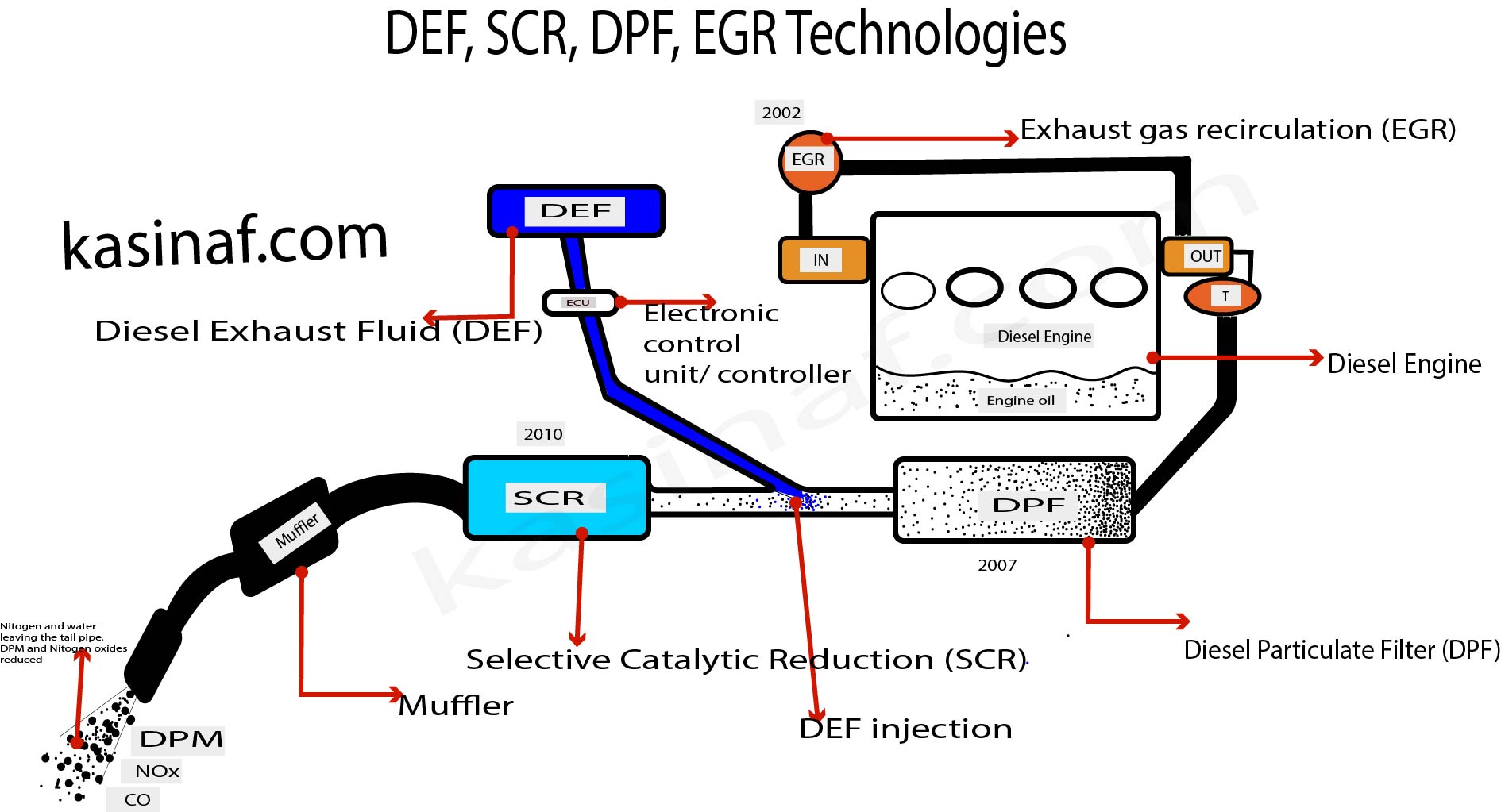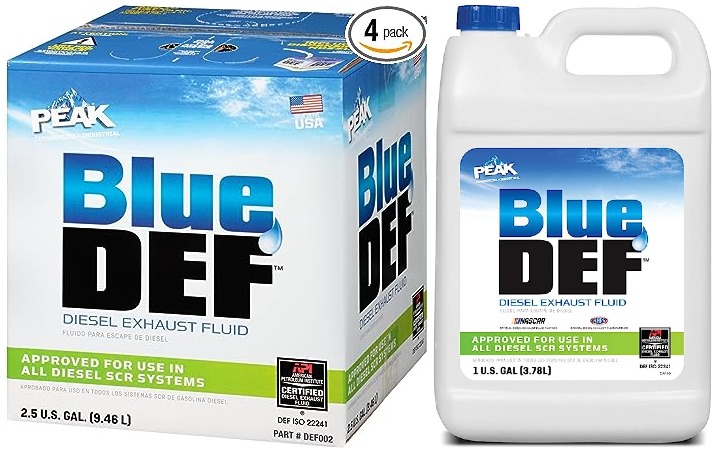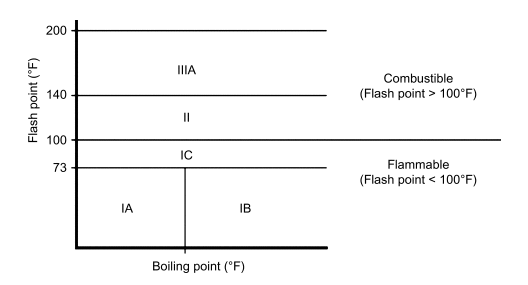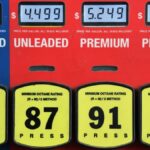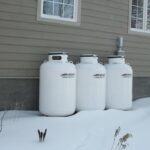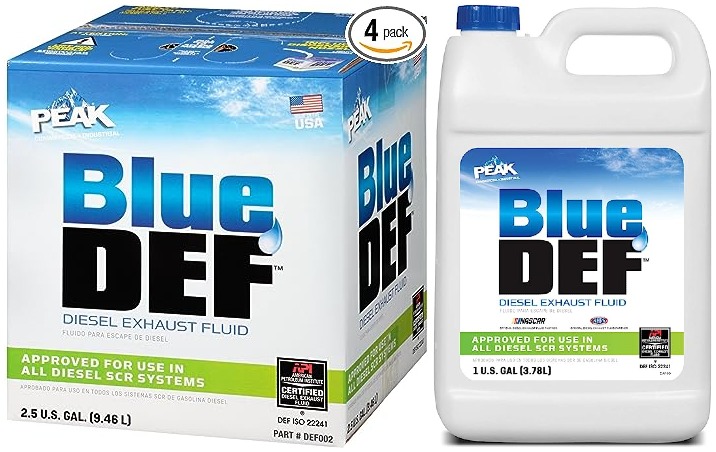
What is DEF?
DEF stands for Diesel Exhaust Fluid. It is a non-toxic, colorless solution used in diesel engines equipped with Selective Catalytic Reduction (SCR) systems to reduce harmful nitrogen oxide (NOx) emissions to harmless Nitrogen and water which are components of air we breathe.
DEF is a mixture of approximately 32.5% high-purity urea and 67.5% deionized water. It is classified as AUS 32 (Aqueous Urea Solution 32.5%) and meets the industry-standard specification known as ISO 22241.
What is the purpose of DEF
The purpose of Diesel Exhaust Fluid (DEF) is to reduce harmful emissions of nitrogen oxide (NOx) in diesel engines equipped with Selective Catalytic Reduction (SCR) systems. DEF is a mixture of high-purity urea and deionized water, and it is injected into the exhaust stream before it reaches the SCR catalyst.
In 2010, the Environmental Protection Agency (EPA) required diesel engines to lower their production of NOx to meet federal emissions guidelines.
When the exhaust gases pass through the SCR catalyst, the DEF undergoes a chemical reaction, known as urea hydrolysis, which converts the harmful nitrogen oxide gases into harmless nitrogen (N2) and water vapor (H2O). This reaction occurs at high temperatures and in the presence of a catalyst.
By using DEF and the SCR system, diesel engines can significantly reduce their NOx emissions, which are known contributors to air pollution and environmental damage. The use of DEF helps diesel engines comply with stringent emissions regulations imposed by organizations like the Environmental Protection Agency (EPA) and other regulatory bodies worldwide.
The SCR system, working in conjunction with DEF, enables diesel engines to achieve better control over emissions without compromising engine performance. It allows for more efficient combustion, reduces the formation of NOx gases, and helps improve fuel efficiency.
When your diesel truck or equipment runs, DEF is injected into the exhaust stream. It is a mixture of synthetic urea and de-ionized water. Inside the exhaust system, DEF reacts with the harmful emissions, breaking them down into harmless nitrogen and water vapor which are components of the air we breath in. This process reduces emissions by up to 90%, helping trucks and heavy machinery operate in an environmentally friendly manner and comply with emissions regulations of Environment Protection Agency (EPA).
In summary, the purpose of DEF is to enable the SCR system to convert harmful nitrogen oxide gases into harmless nitrogen and water vapor, thereby reducing NOx emissions from diesel engines. By using DEF and SCR technology, diesel engines can operate more cleanly and contribute to improved air quality and environmental sustainability.
Effects of Nitrogen Oxide Emissions from Vehicles on Health and Environment
Nitrogen oxide (NOx) emissions from vehicles can have several significant effects on both human health and the environment. As vehicles are one of the major sources of NOx emissions, their impact is particularly relevant in urban areas and areas with high traffic density. Some of the key effects of nitrogen oxide emissions from vehicles include:
- Air Quality and Respiratory Problems: NOx contributes to the formation of ground-level ozone and fine particulate matter, both of which are major components of smog. Exposure to elevated levels of NOx and the pollutants it helps create can cause respiratory issues such as coughing, wheezing, shortness of breath, and worsen pre-existing respiratory conditions like asthma and bronchitis.
- Cardiovascular Issues: Studies have linked long-term exposure to NOx emissions with an increased risk of cardiovascular problems, including heart attacks, strokes, and other heart-related issues. High NOx levels can negatively impact blood vessels and promote inflammation, which can lead to adverse cardiovascular effects.
- Nitric Acid Formation and Acid Rain: NOx can react with other pollutants in the atmosphere, forming nitric acid and other nitrogen-containing compounds. These compounds can be carried by rain and deposited on the Earth’s surface as acid rain, which can harm vegetation, soil, and aquatic ecosystems.
- Ozone Depletion: In the upper atmosphere, NOx can contribute to the depletion of the ozone layer, leading to increased exposure to harmful ultraviolet (UV) radiation from the sun.
- Climate Change: Nitrogen oxides, including NOx, are considered greenhouse gases. They contribute to global warming and climate change by trapping heat in the Earth’s atmosphere, leading to rising temperatures and other environmental consequences.
- Smog Formation: NOx plays a crucial role in the formation of smog, which can reduce visibility and create haziness in urban areas. Smog can also have economic implications, affecting tourism and outdoor activities.
To address the adverse effects of NOx emissions from vehicles, various measures have been implemented, including the use of emission control technologies like Selective Catalytic Reduction (SCR) systems and stricter emissions standards for vehicles. Transitioning to cleaner fuel sources and encouraging the adoption of electric and hybrid vehicles can also help reduce NOx emissions and improve air quality in urban areas. These efforts are crucial in protecting public health and mitigating the environmental impact of vehicle emissions.
DEF Storage, Monitoring, and Availability
DEF is typically stored in a dedicated tank in diesel vehicles, separate from the fuel tank. The DEF tank is equipped with a filler neck and a blue cap to differentiate it from other vehicle fluids. The DEF consumption rate depends on the engine’s performance and operating conditions, with an average usage ratio of approximately 2-3% of diesel fuel consumption.
It is essential to maintain an adequate level of DEF in the tank. Most vehicles have sensors that monitor the DEF level, and a warning light will illuminate on the dashboard when the DEF level becomes low. If the DEF tank runs empty, the engine control unit (ECU) may limit the vehicle’s speed until DEF is refilled.
DEF is widely available at fuel stations, automotive supply stores, and various other locations. It is typically sold in containers ranging from small bottles to larger bulk containers, allowing vehicle owners to conveniently refill their DEF tanks.
DEF is a vital component in the SCR process, helping diesel engines reduce NOx emissions and comply with emissions regulations. By using DEF appropriately and maintaining an adequate supply, diesel vehicle owners can contribute to cleaner air and a healthier environment.
What is Selective Catalytic Reduction?
Selective Catalytic Reduction (SCR) is an advanced emissions control technology used in diesel engines to reduce nitrogen oxide (NOx) emissions. It operates in conjunction with Diesel Exhaust Fluid (DEF) and involves the use of a catalyst located in the exhaust system.
How SCR Works:
SCR utilizes a catalyst, typically composed of platinum, rhodium, and/or palladium, positioned in the exhaust system. When the exhaust gases pass through the SCR catalyst, a chemical reaction takes place. DEF, a mixture of urea and water, is injected into the exhaust stream before entering the catalyst. The DEF reacts with the NOx gases, converting them into harmless nitrogen (N2) and water vapor (H2O). This reaction occurs at elevated temperatures facilitated by the SCR catalyst.
Benefits of SCR:
- Effective NOx Reduction: SCR is highly efficient in reducing NOx emissions, a major contributor to air pollution and environmental damage.
- Regulatory Compliance: SCR enables diesel engines to meet stringent emissions regulations set by organizations like the Environmental Protection Agency (EPA).
- Performance Optimization: SCR allows for more efficient combustion and optimized engine operation without compromising engine performance or fuel efficiency.
Integration with Diesel Exhaust Fluid (DEF): DEF plays a crucial role in the SCR process. It is injected into the exhaust stream as a reductant, reacting with NOx gases in the SCR catalyst to convert them into harmless nitrogen and water vapor. The dosage of DEF is precisely controlled by the engine’s Electronic Control Unit (ECU)/ computer to ensure optimal performance and emissions reduction.
Maintenance and Operation:
To ensure effective SCR performance, it is important to monitor and replenish the DEF supply regularly. Most vehicles are equipped with DEF level sensors that trigger a warning light on the dashboard when the DEF level becomes low. Maintaining an adequate supply of DEF is crucial for the SCR system to function properly and comply with emissions regulations.
SCR is an advanced emissions control technology that, in combination with DEF, significantly reduces NOx emissions in diesel engines. By facilitating the conversion of harmful gases into harmless components, SCR helps meet emissions regulations while maintaining engine performance and efficiency. Proper maintenance and monitoring of DEF levels are essential for the optimal functioning of the SCR system.
SCR is an advanced emissions control technology that, in combination with DEF, significantly reduces NOx emissions in diesel engines. By facilitating the conversion of harmful gases into harmless components, SCR helps meet emissions regulations while maintaining engine performance and efficiency. Proper maintenance and monitoring of DEF levels are essential for the optimal functioning of the SCR system
DEF and SCR: Addressing Emissions Restrictions and Increasing Demand
The Diesel Exhaust Fluid (DEF) and Selective Catalytic Reduction (SCR) systems have become essential components in reducing emissions from diesel engines. With increasing awareness of climate change and the need to minimize emissions, DEF usage has gained significant importance. Let’s explore how DEF and SCR are playing crucial roles in meeting emissions restrictions and addressing the growing demand for cleaner engines.
The EPA issued the Diesel Emission Reduction Act (DERA) in 2010, which emphasized the use of DEF in diesel engines to comply with emissions regulations.
Wide Application of DEF and SCR:
Large semi-trucks have greatly benefited from DEF and SCR systems in reducing their significant emissions.
However, DEF is not limited to trucks; it is used in various other machinery, marine vessels, farm equipment, off-road vehicles, generators, and even consumer vehicles with diesel engines.
Increased Demand and Future Outlook:
As environmental consciousness grows, the demand for DEF is expected to rise further.
The implementation of built-in vehicle monitoring systems, which ensure proper DEF usage and emissions compliance, is likely to become more prevalent.
DEF and SCR technologies will continue to play a crucial role in meeting emissions standards and keeping our environment cleaner.
Environmental Impact:
DEF and SCR systems have significantly contributed to reducing nitrogen oxide (NOx) emissions, which are major pollutants associated with air pollution and respiratory health issues.
By converting harmful gases into harmless nitrogen and water vapor, DEF and SCR enable diesel engines to operate more cleanly and efficiently.
Industry Compliance and Regulation:
- The integration of DEF and SCR systems helps diesel engines comply with stringent emissions regulations set by the EPA and other regulatory bodies as emissions standards continue to
DEF and SCR systems have become vital components in reducing emissions from diesel engines. With the EPA’s emphasis on emissions restrictions and the increasing demand for cleaner engines, DEF has found widespread application across various sectors. As the demand for DEF continues to grow, it will play an instrumental role in addressing emissions challenges and ensuring a cleaner and more sustainable future for diesel-powered vehicles and equipment
Frequently asked questions
HOW MUCH DEF DO I NEED?
To estimate how much DEF you’ll need, consider the consumption rate relative to your fuel usage. On average, diesel engines require about 2-3% DEF in relation to the amount of fuel consumed. Here are a couple of practical examples:
- Example, for a truck with a 20-gallon fuel tank, you can estimate needing approximately 0.4-0.6 gallons of DEF. This means that for every full tank of fuel, it’s advisable to have around 0.4-0.6 gallons of DEF available to maintain optimal emissions control.
- Example for a Car with a 15-Gallon Fuel Tank: For a car with a 15-gallon fuel tank, you can estimate needing around 0.3-0.45 gallons of DEF. This means that with each fuel fill-up, it’s recommended to have approximately 0.3-0.45 gallons of DEF available.
Is DEF the Same as AdBlue?
DEF and AdBlue are similar products used for the same purpose, which is to reduce nitrogen oxide (NOx) emissions in diesel engines equipped with Selective Catalytic Reduction (SCR) systems. However, there can be some slight differences between DEF and AdBlue.
DEF is a more general term used in North America to refer to the urea-based solution used for emissions control. AdBlue, on the other hand, is a specific brand name for DEF that is widely used in Europe, particularly in Germany. AdBlue meets the specific quality standards set by the German Association of the Automotive Industry (VDA).
While DEF and AdBlue have the same fundamental composition and purpose, they may vary slightly in terms of regional regulations, labeling, and packaging. So, while DEF and AdBlue are similar, it’s important to note that AdBlue is a specific brand of DEF.
What Happens When You Run out of DEF?
If you were to run out of Diesel Exhaust Fluid (DEF), modern diesel vehicles are equipped with systems that provide ample warning before the DEF runs out. Here’s what happens when you run out of DEF:
- Warning Indicators: Most diesel vehicles have a dashboard warning system that monitors the DEF level. When the DEF level becomes low, a warning light will illuminate on the dashboard to alert you.
- Engine Limitations: If you continue to operate the vehicle without refilling the DEF, the engine control unit (ECU) will limit the engine’s performance. It may enter a reduced power mode or “limp mode” to ensure emissions compliance.
- Start Prevention: In some cases, when the DEF tank is completely empty, the vehicle’s system will prevent the engine from starting until DEF is refilled. This is a built-in safeguard to ensure proper emissions control.
- Refilling DEF: To rectify the situation, you will need to refill the DEF tank. DEF is widely available at fuel stations, automotive supply stores, and other locations. Once the DEF tank is refilled, the warning indicators should clear, and normal engine operation will resume.
It is important to monitor your DEF levels regularly and refill the tank before it reaches critically low levels to avoid running out of DEF and experiencing engine limitations. Following the manufacturer’s recommendations for DEF maintenance will help ensure smooth and uninterrupted operation of your diesel vehicle.
Where does DEF fluid go?
DEF fluid is added to a separate tank in diesel vehicles, typically located near the fuel tank. The location of the DEF fill port may vary depending on the vehicle make and model. Here are common places where you can find the DEF fill port:
- Under the Hood: In many vehicles, the DEF fill port is located under the hood, often near the engine compartment. It may be labeled or identified by a blue cap to differentiate it from other fluid ports.
- Next to the Fuel Port: Some vehicles have the DEF fill port positioned near the fuel port for convenience. It allows you to refill both the fuel and DEF simultaneously, typically on the same side of the vehicle.
- In the Trunk or Cargo Area: Certain vehicles, such as larger trucks or commercial vehicles, may have the DEF fill port located in the trunk or cargo area. This placement is designed to accommodate larger DEF tanks and facilitate easy access for refilling.
It is essential to use caution when refilling DEF to prevent accidental misfilling. DEF fill ports are typically smaller than fuel ports to reduce the risk of incorrect fluid insertion. Always ensure that you are adding DEF to the correct port and refer to your vehicle’s manual for specific instructions on locating and refilling the DEF tank.
Can You Substitute Water in for DEF?
No, it is not advisable to substitute water for Diesel Exhaust Fluid (DEF). DEF is a specifically formulated solution consisting of purified water and a precise concentration of urea. It is designed to react with the exhaust gases in the Selective Catalytic Reduction (SCR) system to effectively reduce harmful emissions.
Using water instead of DEF can lead to several issues:
Inadequate Emissions Reduction: Water does not contain the necessary urea content required for the SCR system to properly convert nitrogen oxides (NOx) into harmless nitrogen and water vapor. As a result, the vehicle will not meet emissions standards and may produce excessive pollutants.
Potential Damage to the SCR System: The SCR system is designed to work with DEF and relies on its specific composition. Introducing water instead of DEF may cause corrosion or damage to the SCR components, leading to costly repairs or system failure.
Engine Performance and Warranty Issues: Using water instead of DEF can negatively impact the engine’s performance, fuel efficiency, and overall reliability. Additionally, using improper fluids may void the manufacturer’s warranty.
It is crucial to use the correct DEF fluid in your diesel vehicle to ensure optimal emissions control, maintain engine performance, and comply with environmental regulations. Always follow the manufacturer’s recommendations and use DEF from reputable sources to guarantee the proper functioning of the SCR system.
Can a Diesel Engine Run Without DEF?
No, diesel engines won’t run without DEF. If you have completely run out of Def , it won’t start.
The engine wont start because of the following reasons
A diesel engine equipped with a Selective Catalytic Reduction (SCR) system relies on the presence of Diesel Exhaust Fluid (DEF) to effectively reduce nitrogen oxide (NOx) emissions. The Electronic Control Unit (ECU)/ computer, which is the engine’s control system, plays a crucial role in regulating engine functions, including the SCR system.
The ECU is programmed to monitor various parameters, including DEF levels. When the DEF level becomes critically low or depleted, the ECU receives this information and prevents the engine from starting. It does so as a protective measure to ensure that the vehicle remains in compliance with emissions regulations.
By preventing the engine from starting when DEF is unavailable or insufficient, the ECU ensures that the SCR system, which relies on DEF for emissions control, operates within the required parameters. This feature emphasizes the importance of maintaining an adequate supply of DEF to ensure proper engine function, emissions compliance, and environmental responsibility.
Therefore, if a diesel engine runs out of DEF or has an insufficient amount, the ECU will not allow the engine to start as a means of enforcing emissions control requirements and promoting the use of DEF for effective pollution reduction.
Where Can I Order DEF?
To order DEF (Diesel Exhaust Fluid), you have a few options available:
- Fueling Stations: Most fueling stations, particularly those catering to diesel vehicles, offer DEF for purchase. DEF is commonly available at truck stops, service stations, and some standard fuel stations. You can simply fill up your DEF tank at these locations while refueling your vehicle.
- Auto Parts Stores: Many auto parts stores carry DEF in various container sizes. These stores are convenient if you need to purchase DEF quickly and in smaller quantities. You can check with local auto parts stores to see if they carry DEF and what sizes they offer.
- Big Box Stores: Some larger retail stores, such as Walmart or automotive supply chains, may also stock DEF. These stores often have dedicated automotive sections where you can find DEF containers of different sizes. It is recommended to check the automotive or fluid aisle in these stores.
- Wholesale Suppliers: If you prefer to purchase DEF in larger quantities or want to ensure a reliable supply, you can consider ordering DEF from trusted wholesale suppliers. These suppliers specialize in providing DEF to businesses, fleets, and individuals who require larger volumes. This option is ideal for regular fill-ups and proactive maintenance practices.
It is important to ensure that the DEF you purchase meets the necessary quality standards and specifications for your specific vehicle. Always check the labeling and ensure it is certified and approved for use in diesel engines equipped with SCR systems.
How long does diesel fluid or Diesel Exhaust Fluid (DEF) last?
Diesel Exhaust Fluid (DEF), it has a shelf life of approximately one year when stored properly. DEF is a mixture of deionized water and urea, and over time, the urea can undergo a chemical reaction that can affect its quality and effectiveness.
To ensure the longevity and quality of DEF:
- Store in a cool, dry place: DEF should be stored in a temperature-controlled environment, ideally between 12°C (54°F) and 25°C (77°F). Exposure to extreme temperatures, especially high heat, can accelerate the degradation of DEF.
- Avoid contamination: DEF should be kept in a sealed container to prevent contamination by dust, debris, or other substances. Contamination can impact the quality of DEF and its ability to properly function in the SCR system.
- Check the expiration date: DEF containers usually have an expiration date printed on them. It is important to use DEF before the indicated expiration date to ensure its effectiveness.
- Follow first-in, first-out (FIFO) method: If you have multiple containers of DEF, use the oldest stock first to maintain freshness and prevent expired DEF from being used.
It is recommended to purchase DEF in quantities that can be used within its shelf life to avoid any potential degradation in quality. Regularly check the expiration date and storage conditions to ensure that the DEF remains effective and reliable for use in your diesel vehicle.

